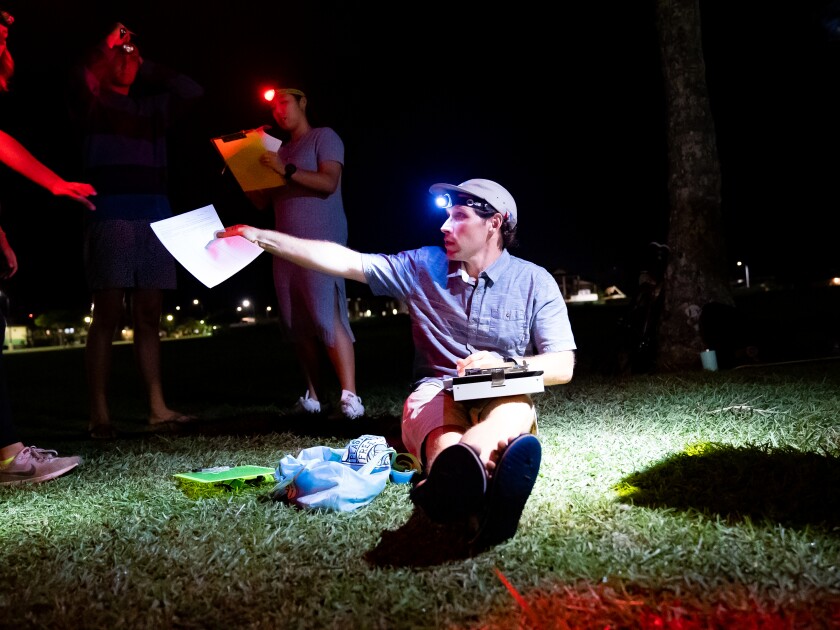
Sterling Kerr, a senior biology major from Utah and the teaching assistant for the animal behavior class, said crickets are “one of the only animals on the earth actively going through an evolutionary process [people] can see with [their] eyes. … They’re a small cog in a really big wheel of things we don’t get to see every day.”
Throughout the Fall 2021 Semester, Kerr said students in the animal behavior class met at the fields in front of the school on Tuesdays and Thursdays, after dark, for their lab. The labs consisted of finding and observing crickets, he explained.
He said the species of cricket they observe is called the oceanic field cricket. This cricket is not native to Hawaii but has built up a large population since it was introduced by Polynesian settlers or by later human activity, he added.
Meanwhile, he said a parasitoid fly originating in North America has also been accidentally introduced to Hawaii and supports itself by preying on the field cricket.
The fly, Kerr explained, finds male crickets by listening to their chirping and lays its eggs in them, which kills the cricket. In order to combat this, he said part of the cricket population is evolving to no longer chirp.
Spencer Ingley, assistant professor in the Faculty of Sciences and teacher of the animal behavior class, said he has been studying this new type of cricket for a little over two two years. He added some of his colleagues he’s collaborating with have been studying these crickets since the 1990s.
“Each fall since 2019, I’ve worked with collaborators to design a semester-long field project that will allow us to collect data that has never before been collected,” he explained.
The evolved crickets are called flatwing crickets due to the change in shape of their wings that prevents their chirps from making any noise, Ingley said, emphasizing how they have only been found so far on Oahu and Kauai. This makes BYUH a “key research site,” according to Ingley.
“This work is important because it is illuminating how [cricket] communication evolves,” he said. For crickets, courtship calls, or chirping, are “vital to the survival of their species” because this is how male crickets attract female crickets in order to mate, Ingley explained.

However, when chirping also attracts parasitoid flies that kill the males, trying to mate is the same as trying to die, Ingley also said.
Ingley further explained to actually survive long enough to breed with an interested female, some male crickets have stopped chirping, thus losing the ability to chirp entirely because of this change in the structure of their wings.
These flatwing males find their mates by approaching the chirping males at the same time as the females do. From there, he said they can steal the girls and become proud parents while the chirping male has eggs laid in him by a fly. The emergence of the flatwing male, Ingley explained, is “this species … evolving in real time.”
After the floods in January 2021 killed part of the cricket population at BYUH, the National Science Foundation gave Ingley and his collaborators a grant to study the crickets in more detail, Ingley said. “I plan on working with this group as long as students are benefiting from this work.”
He continued, “I have great collaborators and great students, so I’m excited to keep it up as long as I can. … My first year here, I was contacted by three different laboratories from the mainland United States and from the United Kingdom to see if I was interested in collaborating on this work.”
He said his collaborators include Dr. Marlene Zuk from the University of Minnesota; Dr. Robin Tinghitella and Dr. Dale Broder from the University of Denver; and Dr. Nathan Bailey from the University of St. Andrews. Ingley works most closely with Tinghitella and Broder, he said, while Tinghitella and Zuk were among the first scientists to document the change in crickets.
According to Ingley, the data the animal behavior class students collect on the crickets may be used in peer-review scientific publications. “By the time our data collection is done, we should have data on about 800 crickets, making up over 60 hours of direct observation.”
During each lab session, he said students pair off and watch what a cricket does for two to five minutes, timestamping and writing down anything the cricket does. They do this for about 20 crickets a night.
Gabe Meyer, a senior marine biology major from Cave Creek, Arizona, and the other teaching assistant for the class, said, “Most crickets are pretty boring. It’s not the most exciting thing in the world to look at a cricket for five minutes at a time.” He said his experience observing crickets usually involves the cricket doing nothing more than “eating or sitting perched on a leaf.”
The data, though, is important, Meyer explained. By observing the behavior of the crickets, scientists come to a better understanding of them, he said. He added what needs to be understood about the crickets is why and how they are rapidly evolving.
“There was once a student who saw a cockroach [eating] a cricket. That’s pretty exciting. Cockroaches are gross,” he said with a smile.
